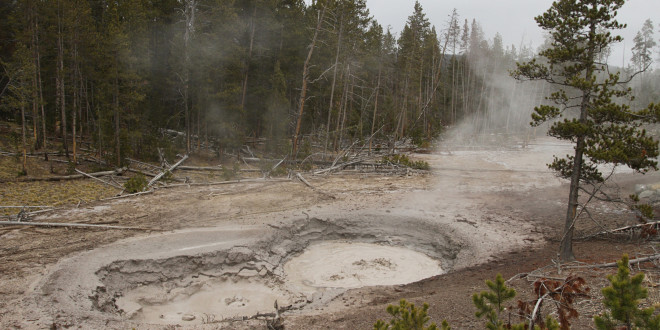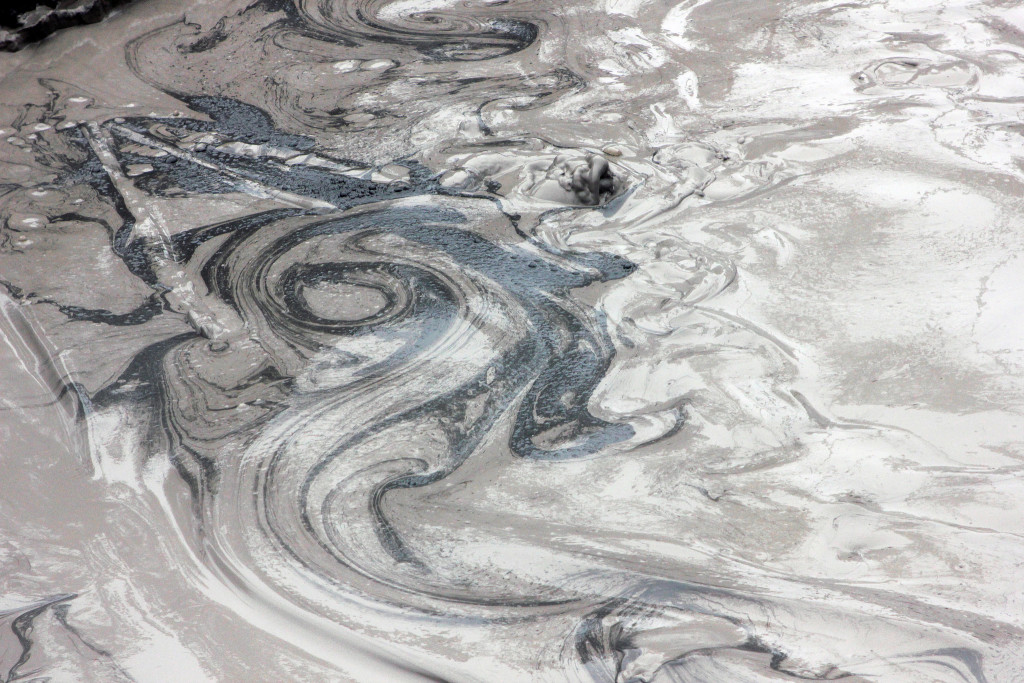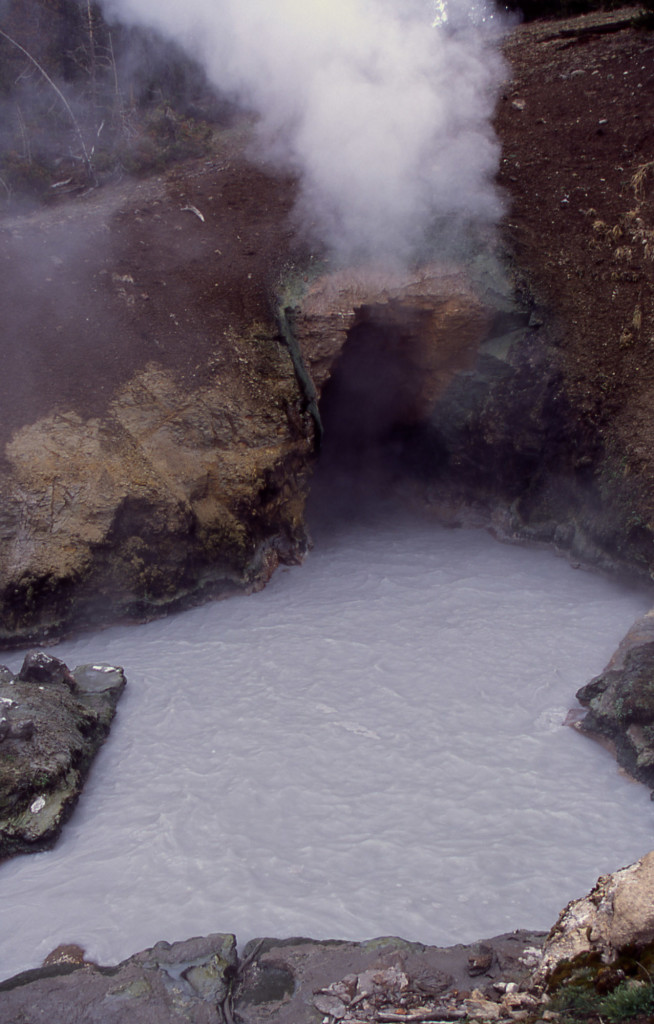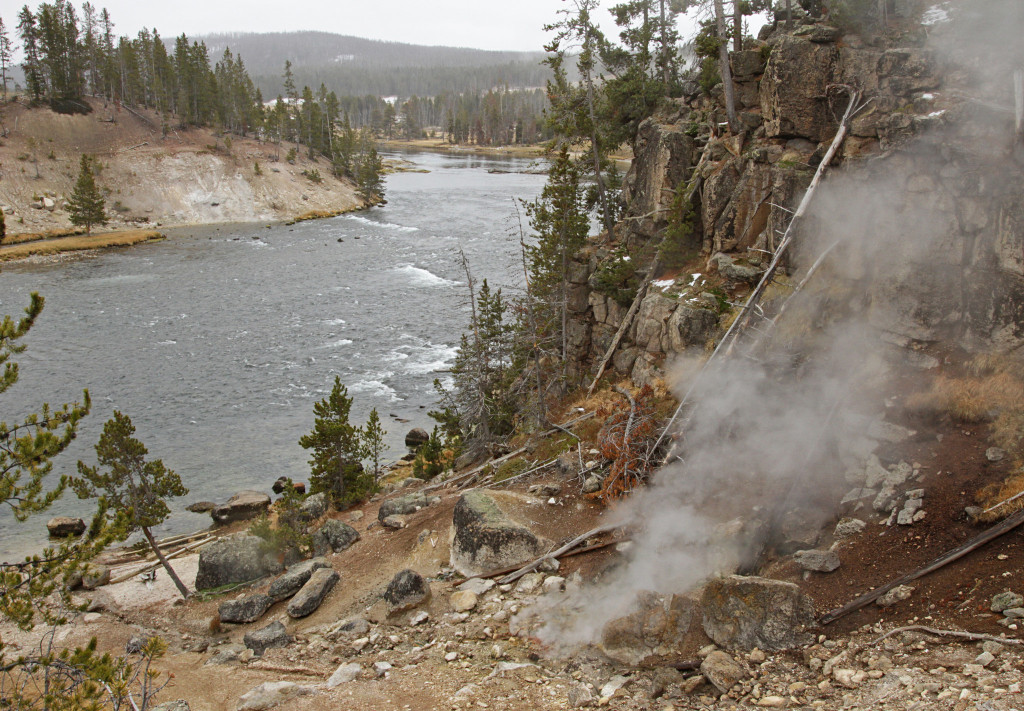The name Mud Volcano sounds pretty dramatic, right?
Maybe you’re imaging something like Krakatoa: a massive cone spewing streaking material. As such, you may be disappointed when you pull up to Yellowstone’s Mud Volcano area to find that the “volcano” is nothing more than a giant pit, which, granted, is muddy. Or maybe that’s what you would think, if you weren’t awestruck by this frothing cauldron.
Alongside West Thumb Geyser Basin, Mud Volcano is the other major geyser area on the east half of Yellowstone National Park. The two offer an outstanding contrast: where West Thumb is known for its relative tranquility and limpid waters, Mud Volcano’s fame rests on its boisterousness and acridity.
Just consider Sulfur Cauldron, not in Mud Volcano proper but just down the way. You can’t get closer than an observation point on the hill just off the Grand Loop Road, something you’ll be thanking your lucky stars for once you get a whiff of the cauldron. And for anyone even remotely tempted to get a closer look: the waters in Sulfur Cauldron rank an average 1.2 on the pH scale—the same as stomach acid. Yikes!
Most of the best attractions in Mud Volcano are located just outside the parking lot. You’ve got the titular feature, as well as Mud Cauldron and Mud Geyser. Our favorite however has nothing to do with mud. Rather, it’s a curious feature located just left of Mud Volcano called Dragon’s Mouth Spring, shown above. It’s a spot where boiling water has gradually eroded away the hillside, creating a cavern that resounds constantly with roaring waters—almost like there really is a dragon lurking in there.
The area was of particular fascination to visitors and surveyors. Geologist and 1871 Hayden Geological Survey member Albert C. Peale wrote at length about the basin in his diary, which was a source of fascination not only for him but the whole Survey as well (taken from historian Marlene Deahl Merrill’s excellent compendium of Hayden Survey materials, Yellowstone and the Great West):
Immediately back of camp I found two crater-like mud springs at the bottom of which, through a bluish mud, the steam was bubbling like boiling mush. There were also two large pools of water fed by a number of springs on the side of the hill. The water tastes strongly of alum and is of dirty greenish color. These springs come through clay instead of through limestone as in the hot springs back on the Gardiner River. After reaching the top of the hill, I could see steam rising from the ravine below, and descending, came first to a sort of cave or grotto which extends 10 to 15 feet into the side of the hill in sandstone. From this gushes forth every few seconds a puff of steam and water which is very clear and flows down a small channel [Dragon’s Mouth Spring]. It would be a delightful place for a vapor bath.
Proceeding a little further, passing a pool of alum water, I came to a huge mud crater at the bottom of which, about 20 feet down, I could [see] every now and then (when the wind blew the steam aside) a seething mass of mud [Mud Volcano]. The trees all about this place are coated with mud showing that it throws out mud sometimes to a considerable height. Here I met Elliott, the Doctor (Hayden), some of General Barlow’s party, and one of their guides, an old trapper who has been in this country before. He took us over to another spring [Mud Geyser] which he assured us would commence spouting about sundown. We sat down on the bank to wait, somewhat incredulous, for the water was quite placid with the exception of the centre which bubbled a little. Soon however the water began to rise gradually, until suddenly, it was thrown into the greatest agitation, becoming very muddy. The water was thrown up about 10 feet every few seconds and a cloud of steam rose from it continually. We gazed on it with wonder. After continuing about twenty minutes it stopped as suddenly as it began and the water became as smooth as the most placid lake, the water, however still very muddy. The trapper says this happens four times a day.
These days, unfortunately, things have changed markedly. According to Park historian Lee H. Whittlesey, Mud Volcano exploded shortly after Peale’s observation; Nathaniel Pitt Langford recounted visiting the basin only to find “a large excavation remained, and a seething, bubbling mass of mud, with several tree-tops swaying to and fro in the midst.” Mud Geyser, meanwhile, has quieted down greatly from its 19th century heyday.
The rest of the Mud Volcano Area has the disadvantage of being on top of the hill, up a steep incline no less. Still, should you make your way to the summit, you won’t be disappointed. Making your way up takes you past the “Cooking Hillside,” which sprawls on both sides of the walkway. Passing that you come across some very suggestively named features: Sizzling Basin, Churning Caldron, Black Dragon’s Cauldron. Then there’s Sour Lake, which just simmers, but ranks alongside Sulfur Cauldron in terms of acidity.
 Yellowstone Insider Your Complete Guide to America's First National Park
Yellowstone Insider Your Complete Guide to America's First National Park




You must be logged in to post a comment.